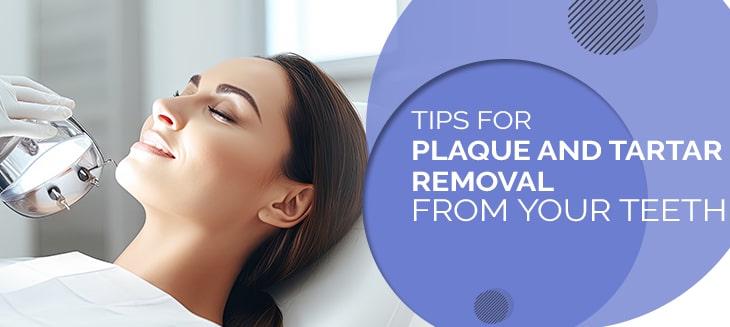 20 Old Brompton Road, South Kensington, London, SW7 3DL
20 Old Brompton Road, South Kensington, London, SW7 3DLWe Are Now Open On Saturdays
We Are Now Open On Saturdays
- Book My Appointment
- 020 31375055
We Are Now Open On Saturdays
We Are Now Open On Saturdays
Located at 20 Old Brompton Road – Just Steps from ![]() South Kensington Tube. Easy Access, Always.
South Kensington Tube. Easy Access, Always.

Tartar, also known as calculus, is the accumulation of plaque and minerals from saliva. It can form a hard, crusty layer on teeth and below the gumline, easily stained by food and drink.
Tartar deposits typically found between and behind teeth, appear brown or yellow. Both tartar and plaque can harm oral health, leading to
Dentists and oral hygienists have the tools to take care of your irritating plaque.
Plaque can harden into tartar within a few hours, so it's important to brush and floss daily. Here are some tips:
Once tartar adheres to teeth, this concrete-like substance cannot be removed through brushing. It requires professional cleaning by a dental hygienist or dentist. These are some of the best ways to remove tartar from teeth.
Removing tartar requires professional assistance, but several practices can help reduce plaque and prevent tartar build-up. These include:
Those who regularly use hydrogen peroxide whitening strips with pyrophosphate for three months had 29% less tartar build-up compared to those who only brushed their teeth.
Drinking green tea can decrease the amount of bacteria in your mouth. If you do not want to drink tea, try a mouthwash with tea in it.
Foods that promote saliva production and require vigorous chewing can help wash away some bacteria in the mouth that produce plaque. The same applies to sugar-free chewing gum.
The device pulses water into the spaces between your teeth to remove bacteria and debris. When used properly, it can be more effective than string floss in reducing plaque.
Those who use a water flosser and a manual toothbrush had at least a 74 percent reduction in mouth plaque, compared to 58 percent for those who used a manual toothbrush and string floss.
Mouthwashes containing bacteria-fighting ingredients like cetylpyridinium, chlorhexidine, and essential oils can help combat plaque and tartar. Use them in conjunction with brushing and flossing.
Look for a tartar or plaque-control rinse and follow the manufacturer's directions.
Periodic professional cleanings are essential for removing tartar build-up. Both traditional and holistic dentists can perform dental cleanings.
Using a hand-held metal scaler, your dentist or hygienist will carefully scrape away tartar. If you have an excessive amount of tartar that has led to gum disease, your dentist may suggest a deep cleaning, which involves root planning and scaling.
You may book a teeth cleaning appointment to remove tartar from your teeth and have a healthy mouth.
The frequency of dental visits should depend on your current oral health and your dentist's recommendation.
Many dentists recommend a dental cleaning and check-up every six months or more frequently if you have gum disease or are at risk of gum disease. You may need more frequent cleanings if you are prone to tartar and plaque build-up.
People who may require cleanings often include:
The inflammation and irritation caused by tartar can lead to gum disease. Gingivitis, the early stage of gum disease, is reversible and characterized by symptoms such as:
Gingivitis can progress to periodontitis, a condition that cannot be reversed. In addition to bleeding, swollen, and tender gums, watch for these signs:
The bacteria that cause periodontitis can enter the bloodstream, increasing the risk of lung and heart disease. Seeking dental care when symptoms arise is crucial. Regular brushing, flossing, and rinsing can help prevent these serious consequences.
The presence of bacteria in the mouth is completely normal. However, when plaque isn't removed through regular brushing and flossing, it can harden into tartar, which can lead to dental problems such as cavities and gum disease. Brushing, flossing, and regular dental cleanings are essential for maintaining good oral health and preventing tartar build-up.
Tartar can build up on teeth when plaque is not removed through regular oral hygiene practices. It's common for tartar to accumulate over time, which is why regular dental cleanings are important for maintaining oral health.
Tartar forms when plaque, a sticky film of bacteria, saliva, and food particles, is not removed from the teeth. Plaque can mineralize and harden into tartar within 24 to 72 hours if not removed through proper oral hygiene practices like brushing and flossing. Once tartar develops, it cannot be removed by brushing alone and requires professional dental cleaning.
The build-up of tartar can lead to various oral health issues, including gum disease and tooth decay. Tartar appears as a yellow or brownish deposit on the teeth, especially along the gum line. It can also cause bad breath and make teeth appear discolored.
Preventing tartar build-up involves maintaining good oral hygiene practices, including brushing teeth twice a day with fluoride toothpaste, flossing daily, and regular dental check-ups and cleanings. Additionally, limiting sugary and starchy foods can help reduce plaque formation, which can ultimately prevent tartar build-up.
Though the build-up of tartar is a common thing, it can have a big effect on your quality of life. With regular brushing, flossing, periodic dental cleanings and oral checkups, you can prevent the problem of plaque easily. Feel free to visit www.dentalhygienist.london/ for booking an initial consultation today and get rid of plaque and tartar for a healthy mouth.